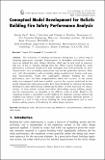Conceptual Model Development for Holistic Building Fire Safety Performance Analysis
Author(s)
Park, Haejun; Meacham, Brian J.; Dembsey, Nicholas A.; Goulthorpe, Mark
Download10694_2013_Article_374.pdf (780.8Kb)
OPEN_ACCESS_POLICY
Open Access Policy
Creative Commons Attribution-Noncommercial-Share Alike
Terms of use
Metadata
Show full item recordAbstract
The evaluation of building performance during fires is a critical step in designing appropriate strategies. Inappropriate or incomplete performance evaluations can mislead fire safety design solutions, which may in turn result in unacceptable loss of life or building damage from fire. While various building fire safety performance evaluation models have been developed, they focus primarily on ‘hard’ characteristics, such as building construction type and fire protection measures. However, ‘soft’ characteristics, such as building design (architectural) features and occupant characteristics, which also significantly influence building fire safety performance, have not been comprehensively taken into account. In the current study, two conceptual performance models: a generic fire response model and an integrated characteristic interaction model, have been developed to represent the holistic building fire safety performance considering the effects of both hard and soft characteristics. In these models, various cause-effect relationships among building, people, and fire characteristics are identified at the different levels of detail. Based on the conceptual models, a quantitative model utilizing the parameter ranking method and weighted sum method, which are commonly used in analytical hierarchy process, is proposed as a tool to help evaluate building fire safety performance and to assist decision making process of developing fire safety design solutions.
Date issued
2013-11Department
Massachusetts Institute of Technology. Department of ArchitectureJournal
Fire Technology
Publisher
Springer US
Citation
Park, Haejun et al. “Conceptual Model Development for Holistic Building Fire Safety Performance Analysis.” Fire Technology 51.1 (2015): 173–193.
Version: Author's final manuscript
ISSN
0015-2684
1572-8099